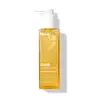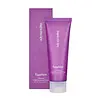What's inside
What's inside
 Key Ingredients
Key Ingredients

 Benefits
Benefits

 Concerns
Concerns

 Ingredients Side-by-side
Ingredients Side-by-side

Water
Skin ConditioningDecyl Glucoside
CleansingCocamidopropyl Betaine
CleansingHydroxypropyl Starch Phosphate
Butylene Glycol
HumectantGlycolic Acid
BufferingGlycerin
HumectantMandelic Acid
Antimicrobial1,2-Hexanediol
Skin ConditioningSodium Hydroxide
BufferingSodium Chloride
MaskingTromethamine
BufferingAmorphophallus Konjac Root Powder
AbrasiveGluconolactone
Skin ConditioningCitrus Junos Fruit Extract
Skin ConditioningAnanas Sativus Fruit Extract
Skin ConditioningSalix Alba Bark Extract
AstringentHamamelis Virginiana Extract
AntiseborrhoeicLactobacillus/Rice Ferment
Skin ConditioningBifida Ferment Lysate
Skin ConditioningSalvia Officinalis Leaf Extract
CleansingSodium Hyaluronate
HumectantHyaluronic Acid
HumectantHydrolyzed Hyaluronic Acid
HumectantHydrolyzed Sodium Hyaluronate
Skin ConditioningHydroxypropyltrimonium Hyaluronate
Potassium Hyaluronate
Skin ConditioningSodium Acetylated Hyaluronate
HumectantZinc PCA
HumectantMaltitol
HumectantAllantoin
Skin ConditioningSodium Hyaluronate Crosspolymer
HumectantXanthan Gum
EmulsifyingArginine
MaskingPentylene Glycol
Skin ConditioningEthylhexylglycerin
Skin ConditioningWater, Decyl Glucoside, Cocamidopropyl Betaine, Hydroxypropyl Starch Phosphate, Butylene Glycol, Glycolic Acid, Glycerin, Mandelic Acid, 1,2-Hexanediol, Sodium Hydroxide, Sodium Chloride, Tromethamine, Amorphophallus Konjac Root Powder, Gluconolactone, Citrus Junos Fruit Extract, Ananas Sativus Fruit Extract, Salix Alba Bark Extract, Hamamelis Virginiana Extract, Lactobacillus/Rice Ferment, Bifida Ferment Lysate, Salvia Officinalis Leaf Extract, Sodium Hyaluronate, Hyaluronic Acid, Hydrolyzed Hyaluronic Acid, Hydrolyzed Sodium Hyaluronate, Hydroxypropyltrimonium Hyaluronate, Potassium Hyaluronate, Sodium Acetylated Hyaluronate, Zinc PCA, Maltitol, Allantoin, Sodium Hyaluronate Crosspolymer, Xanthan Gum, Arginine, Pentylene Glycol, Ethylhexylglycerin
Water
Skin ConditioningGlycerin
HumectantSodium Cocoyl Glycinate
CleansingSodium Lauroyl Glutamate
1,2-Hexanediol
Skin ConditioningButylene Glycol
HumectantHydroxypropyl Starch Phosphate
Solanum Melongena Fruit Extract
Skin ConditioningLauryl Betaine
CleansingHydroxyacetophenone
AntioxidantEthylhexylglycerin
Skin ConditioningSodium Chloride
MaskingDecylene Glycol
Skin ConditioningTocopherol
AntioxidantGluconolactone
Skin ConditioningBetaine Salicylate
AntimicrobialCitric Acid
BufferingWater, Glycerin, Sodium Cocoyl Glycinate, Sodium Lauroyl Glutamate, 1,2-Hexanediol, Butylene Glycol, Hydroxypropyl Starch Phosphate, Solanum Melongena Fruit Extract, Lauryl Betaine, Hydroxyacetophenone, Ethylhexylglycerin, Sodium Chloride, Decylene Glycol, Tocopherol, Gluconolactone, Betaine Salicylate, Citric Acid
 Reviews
Reviews

Ingredients Explained
These ingredients are found in both products.
Ingredients higher up in an ingredient list are typically present in a larger amount.
1,2-Hexanediol is a synthetic liquid and another multi-functional powerhouse.
It is a:
- Humectant, drawing moisture into the skin
- Emollient, helping to soften skin
- Solvent, dispersing and stabilizing formulas
- Preservative booster, enhancing the antimicrobial activity of other preservatives
Butylene Glycol (or BG) is used within cosmetic products for a few different reasons:
Overall, Butylene Glycol is a safe and well-rounded ingredient that works well with other ingredients.
Though this ingredient works well with most skin types, some people with sensitive skin may experience a reaction such as allergic rashes, closed comedones, or itchiness.
Learn more about Butylene GlycolEthylhexylglycerin (we can't pronounce this either) is commonly used as a preservative and skin softener. It is derived from glyceryl.
You might see Ethylhexylglycerin often paired with other preservatives such as phenoxyethanol. Ethylhexylglycerin has been found to increase the effectiveness of these other preservatives.
Gluconolactone is a PHA. PHAs are a great gentle alternative to traditional AHAs.
When applied, Gluconolactone has the same affect on skin as AHAs such as lactic acid. It helps dissolve the dead skin cells in the top layer of your skin. This improves texture and brightens the skin.
PHAs are more gentle than AHAs due to their larger structure. They do not penetrate as deeply as AHAs and take a longer time to dissolve dead cells. Studies show PHAs do not cause as much irritation.
Gluconolactone has some interesting properties:
In a 2004 study, Gluconolactone was found to prevent UV damage in mouse skin cells and has not been found to increase sun sensitivity. However, we still recommend wearing SPF daily.
This ingredient is is an created by reacting gluconic acid with an alcohol.
Learn more about GluconolactoneGlycerin is already naturally found in your skin. It helps moisturize and protect your skin.
A study from 2016 found glycerin to be more effective as a humectant than AHAs and hyaluronic acid.
As a humectant, it helps the skin stay hydrated by pulling moisture to your skin. The low molecular weight of glycerin allows it to pull moisture into the deeper layers of your skin.
Hydrated skin improves your skin barrier; Your skin barrier helps protect against irritants and bacteria.
Glycerin has also been found to have antimicrobial and antiviral properties. Due to these properties, glycerin is often used in wound and burn treatments.
In cosmetics, glycerin is usually derived from plants such as soybean or palm. However, it can also be sourced from animals, such as tallow or animal fat.
This ingredient is organic, colorless, odorless, and non-toxic.
Glycerin is the name for this ingredient in American English. British English uses Glycerol/Glycerine.
Learn more about GlycerinHydroxypropyl Starch Phosphate is a modified starch used to help thicken a product.
It is also used in foods.
Chances are, you eat sodium chloride every day. Sodium Chloride is also known as table salt.
This ingredient has many purposes in skincare: thickener, emulsifier, and exfoliator.
You'll most likely find this ingredient in cleansers where it is used to create a gel-like texture. As an emulsifier, it also prevents ingredients from separating.
There is much debate on whether this ingredient is comedogenic. The short answer - comedogenic ratings don't tell the whole story. Learn more about comegodenic ratings here.
The concensus about this ingredient causing acne seems to be divided. Research is needed to understand if this ingredient does cause acne.
Scrubs may use salt as the primary exfoliating ingredient.
Learn more about Sodium ChlorideWater. It's the most common cosmetic ingredient of all. You'll usually see it at the top of ingredient lists, meaning that it makes up the largest part of the product.
So why is it so popular? Water most often acts as a solvent - this means that it helps dissolve other ingredients into the formulation.
You'll also recognize water as that liquid we all need to stay alive. If you see this, drink a glass of water. Stay hydrated!
Learn more about Water